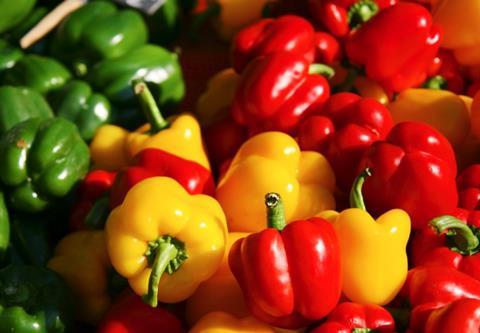
The weather may be improving in southern Spain but the impact that recent flooding, snow and ice has had on suppliers will be felt for several weeks to come.
It was the ‘courgette crisis’ that made headlines but this was by no means the only crop affected by devastating conditions in several European production areas, including Italy, France and Germany, as well as Morocco. Salad vegetables – most notably peppers and tomatoes – were also badly hit.
One Spanish pepper supplier affected was Ejidomar, which produces around 20 million kg of peppers a season for customers across Europe. Almeria, where the company’s growers are based, saw heavy rain, snow and low temperatures, which significantly limited supply. Volumes are down by around 20 per cent, according to Ejidomar director Rafael Roldán.
Recent night time lows of 0-3°c have stopped California peppers maturing and changing colour, leaving too many green and not enough yellow, orange or red peppers. Ejidomar’s chilli and sweet Palermo peppers have also been hit.
The shortage has not reduced the company’s volumes to the UK, with Ejidomar prioritising the European customers it has contracts with – including a major UK supermarket. But this has not been the case with other larger suppliers.
Heavy rainfall and cool temperatures hit the south-eastern regions of Andalusia and Murcia in early December and Spanish pepper prices have now been up for almost two months. Roldán has never experienced such sustained price inflation. “It’s unbelievable,” he says. “I haven’t lived this situation before.”
Wholesale prices for Spanish peppers shot up in the first two weeks of January with 5kg of yellow capsicums rising from £8.02 to £13.50 and red peppers rising from £6.69 to £12. Round tomato prices also skyrocketed, more than doubling in the first three weeks of the year (see graph on next page). Prices in all three products have started to come down now, but remain well above average.
These price rises are being passed onto the consumer at some UK retailers, with some Spanish and Moroccan salad veg going up in price at Aldi, Lidl, Morrisons and Sainsbury’s. The biggest price hikes have been seen at the two discounters.
While these price rises are likely to have been influenced by exchange rate volatility as well as supply shortages, they are also indicative of a squeezed market – particularly at the discounters where putting up prices is a last resort.
Either way, “these prices are not good for anybody,” says Roldán. “They’re not good for us, they’re not good for the consumer – and growers only have these prices because they haven’t got the volume. At the end of the day, it’s better to have a stable price and a normal volume coming through.”
Responding to the crisis, pepper producer Pleun van Malkenhorst of Rainbow UK reports that many of his Dutch colleagues that use LED lights are pushing for an early harvest to “fill the supply gap where they can”. They have “been looking to start harvesting green peppers in week five or six this year,” he says.
Lee Stiles of Lea Valley Growers, meanwhile, has called on British retailers to support British importers and growers with operations in Spain, by raising their prices to reflect higher costs. He also says that growers have been putting contingency plans into place to ensure supply is not compromised. “I have heard of increased imports arriving from the US during the winter,” he says.
The UK industry may be finding ways to cope with the crisis, but with volumes low and prices high suppliers are not out of the woods yet.



